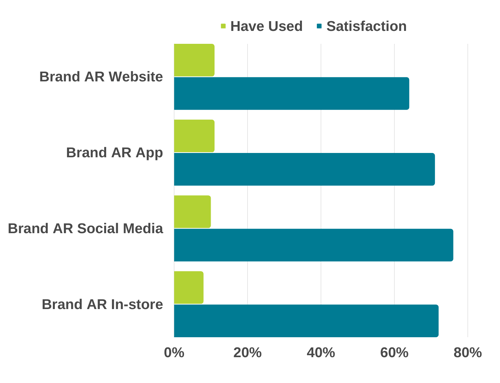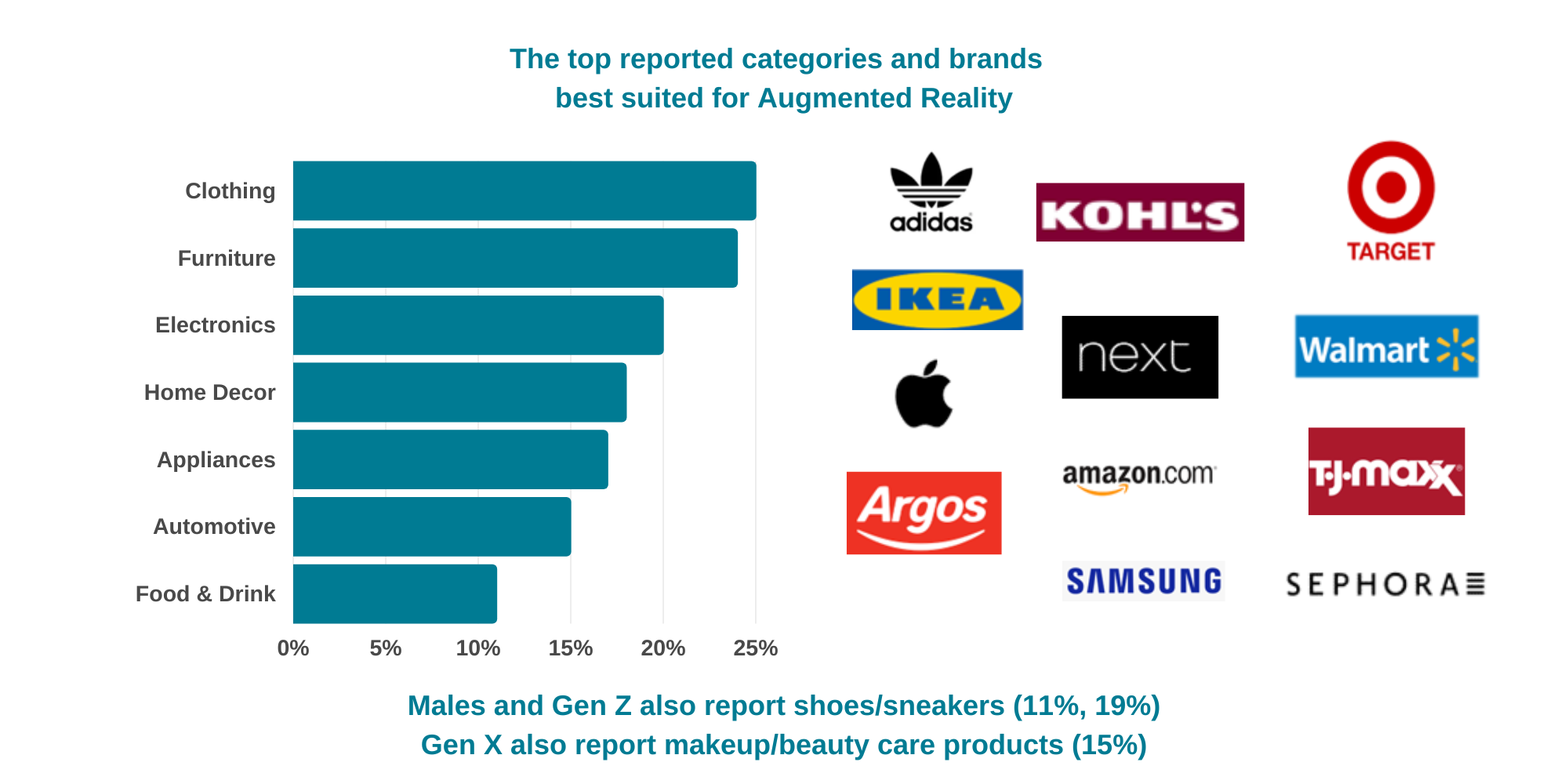
There is a lot of hype around the Metaverse, and while it is still finding its way, mixed and virtual realities are set to become part of our daily lives.
This is especially true in a post-pandemic world where Covid-19 significantly propelled the adoption of virtual technologies. The augmented and virtual reality market for the retail industry alone is expected to reach $2,094.08 billion by 2027, a growth rate of 69% between 2020 to 20271. As these technologies mature, businesses and brands will need to stay ahead and understand that virtual experiences require new ways of thinking to forge brand relationships and communities.
Gaming and entertainment are driving forces behind virtual technology. Applications such as workplace training, meetings and education are growing, but there is room for so much more. Therefore, virtual technology is a space buzzback is following closely. Earlier this year we conducted groundwork research that revealed 70% of US and UK consumers have heard of the Metaverse, and half say they plan to spend some amount of time there in the future. While 40% see it as a place to socialize, 50% desire to learn more about products and services offered. However, less than 20% say they are likely to make a purchase in the Metaverse.
This inspired us to look beyond 3D virtual worlds and dig deeper into the types of innovative technology marketers can leverage to increase brand awareness, build trust, and ultimately drive conversion and loyalty of products and services as the technology matures beyond a trend. Here’s what we learned when surveying general population consumers in the US and UK on augmented reality (AR)2 and virtual reality (VR)3, and our recommendations for brands to enter and play in this space.
1. Timing is Paramount
Early adopters can have a competitive advantage, but being first isn’t always best. When investing to adopt new technologies for marketing products and services, brands don’t want to be too early when consumers aren’t ready, or too late and miss an important window. The technology needs to be seamlessly in place to fully support the user experience. Our recommendation is to get the fundamentals right first and wait for the best time and way to enter – and this may vary depending on what category you’re in.
2. Walk before you run
No one can predict when the market will be ripe for companies to enter the virtual space, so while working to get the basics right, brands can consider starting small. Test and learn without spending the bulk of marketing budgets upfront until you’ve identified consumer acceptance for your category and potential. A killer app that accelerates augmented reality commerce could go a long way. Leverage more app-based solutions before full virtual alternatives.
While a small percentage have experienced a brand’s
AR platform(s) to date, satisfaction is high.

47% are extremely or very interested in using Augmented Reality filters
(apps, websites, or social media) in the future
(particularly US Males 70% and UK Females 43%).
When asked about categories best suited for augmented reality, consumers had a long list of categories, but most brands mentioned were retailers. While at this stage consumers may expect retailers to provide augmented reality, it indicates an opportunity for brands to play early in this space.

3. Presence alone won’t scale commerce
Tech should not be so forward that consumers are confused by it. Brands need to understand what consumers want from them and how to deliver it in an exciting new and different reality. Creating clear, easy-to-use, and unique value for branded experiences in these new spaces will be critical to virtual strategies. We suggest exploring reactions to early-stage ideas – even interactive stimuli – to determine if they’re worth taking forward to further development.
|
For example, Burberry wanted to provide an immersive experience of the relationship between the physical and digital worlds to generate excitement for a new concept. They launched a pop-up AR experience in Harrods to coincide with the launch of its new Olympia bag. Customers were able to watch the Elphis statue walk around in their surroundings and take a video to share on social media. Gucci’s approach was more functional, and retail focused as one of the first brands to invest in AR technology adding a feature to its app to let users ‘try on' sneakers to help them make more informed product decisions. More recently, they released a pair of virtual sneakers, which are designed to only be worn and shared online. The ‘digital-only’ trainers can be bought via the Gucci app for $17.99. |
.png?width=2000&height=1000&name=ARVR%20Pillar%20Page%20Graphics%20(1).png)
4. Capitalize on the most engaged users first
Content creators and influencers tend to be the most interested in immersive spaces. Those who are more engaged with technology are more likely to promote it. Brands can tap into engaged groups to become ambassadors to friends and family who create awareness and move them to purchase. Currently, men (especially in the US) are significantly more engaged digitally compared to women.
.png?width=2000&height=1000&name=ARVR%20Pillar%20Page%20Graphics%20(2).png)
5. Look to target younger audiences
Millennials, Gen Z and Gen Alpha are “growing up” with this technology. These generations crave interaction, connectivity, and a lot of creative content. Capturing and engaging with them early and often in the ways they desire will help form and solidify brand loyalty at early stages.
When looking at technology importance factors across generations, big differences are present even between neighboring generations. As you can see in the chart below, Millennials are much more likely to consider a brand's technology when deciding what brand to purchase.
.png?width=2000&height=1000&name=ARVR%20Pillar%20Page%20Graphics%20(3).png)
In addition, Millennials have had significantly higher AR usage in the past two years vs. Gen X, with usage 2 to 5 times higher. Millennials are more interested in using alternative reality platforms in the future, compared to Gen X (65%, 48% respectively).
|
“I would use (AR/VR) even more if it added to the overall purchase process by including additional information that could not be experienced or gathered elsewhere.” – US Male |
In closing, marketing with augmented and virtual reality will allow brands to create unique experiences engaging consumers and encouraging conversions in fresh interesting ways. Companies equipped with the right strategy and tools to virtually replicate physical instances of shopping while eliminating many of the obstacles will be true disruptors, enabling them to reach consumers with the information and experiences they desire. However, timing needs to be right, the infrastructure needs to be in place, and the targeting / messaging needs to be spot-on.
At buzzback, helping you understand what motivates your consumer – who they are, what's important to them and why – is the first step to exploring augmented and virtual realities. You may need to dive deep into how they're using technology in your category to best inform your strategy. If you’d like more insight on how your brand can have a presence in virtual worlds or even help shape the landscape of the Metaverse, contact us at: info@buzzback.com. We’ll share ways we’re exploring user experience, shopper journey, consumer profiling, concept development, messaging & positioning communications and more. Be sure to follow us as we track this space over time and further dive into the habits and behaviors of engaged users.
________________________________________________________________________________
[1] forbes.com/sites/forbestechcouncil/2021/09/14/augmented-and-virtual-reality-after-covid-19
[2] Using a filter where real objects are enhanced by digitalized information, and virtual objects can appear within the real-world environment to engage with stores or brands for a unique sensory experience.
[3] Using physical technology such as 3D goggles, gloves, or vests to enhance a user’s experience with in a seemingly real way.